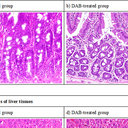Brain derived metastatic prostate cancer DU-145 cells are effectively inhibited in vitro by guava (Psidium gujava L.) leaf extracts.
Keywords
Coimriú
The aqueous extract of Psidium guajava L. (PE) inhibited the cancer cell DU-145 in a dose- and time-dependent manner. At 1.0 mg/mL, PE reduced the viability of PCa DU-145 (the androgen independent PCa cells) to 36.1 and 3.59%, respectively after 48 h and 72 h of incubations. The absolute cell viability suppressing capability (VSC)(AC) could reach 262.5 cells-mL-h/mg on exposure to PE for 72 h, corresponding to the safe ranges, i.e. the percent viability suppressing rates (PVSR) of 2.72 and 2.41 folds for DU-145 comparing to PZ-HPV-7 cells when treated with PE at 0.5 and 1.0 mg/mL respectively for 72 h. In addition, the colony forming capability of DU-145 cells was apparently lowered. The suppressing rates of which reached 8.09 and 5.96 colony/mg/day for D-145 and PZ-HPV-7 cells, respectively within the concentration range of PE at 0.1 asymptotically equal to 0.25 mg/mL. Cell cycle arrests at G0/G1 phase in both cells were observed by TUNEL assay and flow cytometric analysis, yet more prominently evident in DU-145. In addition, suppression of the matrix metalloproteinases MMP-2 and MMP-9, and the upregulation of active caspase-3 at 0.10 to 1.0 mg/mL in DU-145 were also effected in a dose-dependent manner by PE at 0.25 to 1.0 mg/mL, implicating a potent anti-metastasis power of PE. Conclusively, we ascribe the anticancer activity of PE to its extraordinarily high polyphenolic (165.61 +/- 10.39 mg/g) and flavonoid (82.85 +/- 0.22 mg/g) contents. Furthermore, PE might be useful for treatment of brain derived metastatic cancers such as DU-145, acting simultaneously as both a chemopreventive and a chemotherapeutic.



